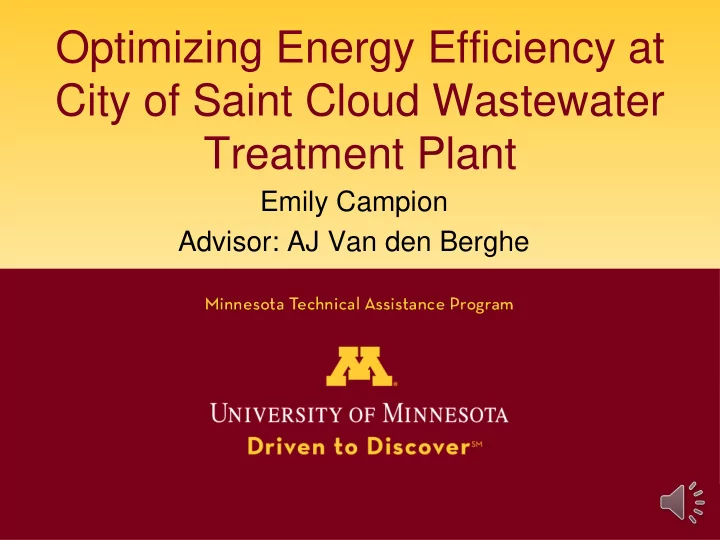

Optimizing Energy Efficiency at City of Saint Cloud Wastewater Treatment Plant Emily Campion Advisor: AJ Van den Berghe
Company Overview • Treats industrial, commercial, and residential wastewater prior to discharge into the Mississippi River • Cities Served: – St. Cloud – St. Joseph – Sartell – Sauk Rapids – St. Augusta – Waite Park
Wastewater Treatment Process • Biological Nutrient Removal (BNR) – Removes nitrogen and phosphorous from wastewater using bacteria – Bacteria require a dissolved oxygen concentration of 2 mg/L
600 HP Turblex Blowers • Proprietary Dual- Point Control™ Inlet Guide Variable Vanes Diffusers http://www.energy.siemens.com/us/pool/hq/compression/special-applications/aeration/STC-GO%20Brochure_EN_lay_120312.pdf
Motivations for Change • Commitment to Energy Efficiency and Resource Recovery • Decrease blower energy use Total Plant Electrical Energy Use 7,000,000 6,000,000 5,000,000 Energy (kWh) 4,000,000 3,000,000 2,000,000 1,000,000 0 2010 2011 2012 2013
Reasons for MnTAP Assistance • Prevent blower Compression surging • Optimize aeration Inlet process to maintain the dissolved Outlet oxygen setpoint of 2 mg/L
Approach • Calculate blower energy use with the Aeration Model – Trend data using SCADA software
Process Investigation • • Decreasing blower differential pressure decreases the power consumption Fan Affinity Law • 3 P=Power (kW) – 𝑄 ℎ 1 1 = h=differential pressure (psia) 𝑄 2 ℎ 2 • The pressure is decreased by opening downstream valves (Most-Open Valve Control)
Most-Open Valve Control Strategy
Most-Open Valve Comparison • Before MOV • After MOV
Most-Open Valve Results • Decreased blower discharge pressure from 22.3 psia to 21.5 psia • Eliminated blower surging • Allowed blower to decrease capacity
Turblex Master Control Panel • Automate Most-Open Valve Control Strategy – Saves labor associated with optimization and programming • Improve Dissolved Oxygen Control – Maintains setpoint of 2 mg/L • Master Control Panel was quoted for $88,500
Modeled Savings Energy Net Savings Simple Reduced (per year) Payback Status (per year) Period (yr) Most-Open 392,000 Valve Control $27,000 Immediate Implemented kWh Strategy Master 766,000 Under $54,000 1.6 Control Panel kWh Review • Turblex Master Control has larger savings because of better dissolved oxygen control
Successful Process Changes • Improve existing Most-Open Valve program to mimic Turblex Master Control – Less variance in dissolved oxygen concentration • Saved energy by enabling the blower to operate at lower capacity • Eliminated blower surging
Personal Benefits • Collaborative teamwork • Continuous processes, chemical engineering equipment • Equipment efficiency • Process Control • Contractors, Vendors, and Utilities • Meetings and presentations
Questions?
Recommend
More recommend